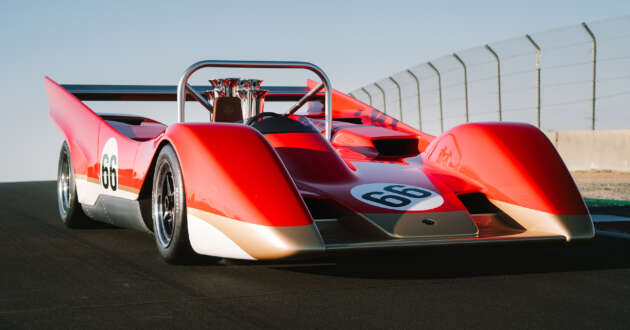At the Monterey Car Week in California, United States, Lotus has unveiled the Lotus 66, a present-day, track-only reimagination of what was supposed to be the British sports car maker’s entry into Canadian-American Challenge Cup, or Can-Am sports car racing in the late 1960s to 1980s.
The Lotus 66 is a present-day form of a ‘lost Lotus’ that had been imagined in technical drawings and scale models but had not come to fruition due to the firm’s focus on Formula 1 in that era, and which has now been commissioned for limited production through digitised drawings, 3D renders and modern construction methods and materials.
Original documents for the designs of the Lotus 66 were held by managing director of Team Classic Lotus, Clive Chapman, who is the son of Colin Chapman.


This will see the Lotus 66 use a period-representative chassis that employs extruded aluminium sections, bonded joints and aluminium honeycomb panels for authenticity, but with modern elements such as the use of computational fluid dynamics (CFD) to result in a maximum downforce figure of 800 kg at 240 km/h, which Lotus says is far more than the original designs would have been able to achieve.
Its powerplant is a mid-mounted, also ‘period representative’ push-rod V8 engine of unspecified make, featuring the iconic air intake trumpets which are visible atop the engine through the car’s bodywork. The engine also gets modern components such as a crankshaft, connecting rods and pistons made of forged aluminium, and produce in excess of 830 hp at 8,800 rpm and 746 Nm of torque at 7,400 rpm.
Transmission is by a modern sequential racing gearbox with reverse gear, along with further modernities such as electric power steering, racing ABS, and an anti-stall multi-plate clutch. Further driver comforts include a modernised driver compartment, inboard fuel cell and a fixed rollover bar; according to Lotus, the original sketches featured a cockpit enclosure.


With the uses of ‘driver-in-the-loop’ technology, Lotus has been able to virtually test the Lotus 66 on circuits such as Silverstone, Fuji and Spa-Francorchamps, where the car has been found to match the performance of a modern GT3-class race car. At circuits such as Laguna Seca, simulations suggest the Type 66 could even be quicker than said modern GT3 cars, says Lotus.
There has been a modern reinterpretation of a ’70s-era racing Lotus, that is the coach-built Radford Type 62-2 that was inspired by the original Lotus Type 62 race car. That is a more modern, road-going proposition, with an Emira-sourced 3.5 litre supercharged V6 and amenities such as a rear camera, touchscreen with Bluetooth and Wi-Fi, and a sound system.
As for the Lotus Can-Am racer that wasn’t to be in its original era, the Lotus 66 launched for the British sports car maker’s 75th anniversary year will be put into limited production of just 10 units, each to be priced “in excess of £1million,” or more than RM5.9 million.










The post Lotus Type 66 – reimagined Can-Am racer design with 830 hp/746 Nm pushrod V8; quicker than GT3 racers appeared first on Paul Tan's Automotive News.


0 Comments